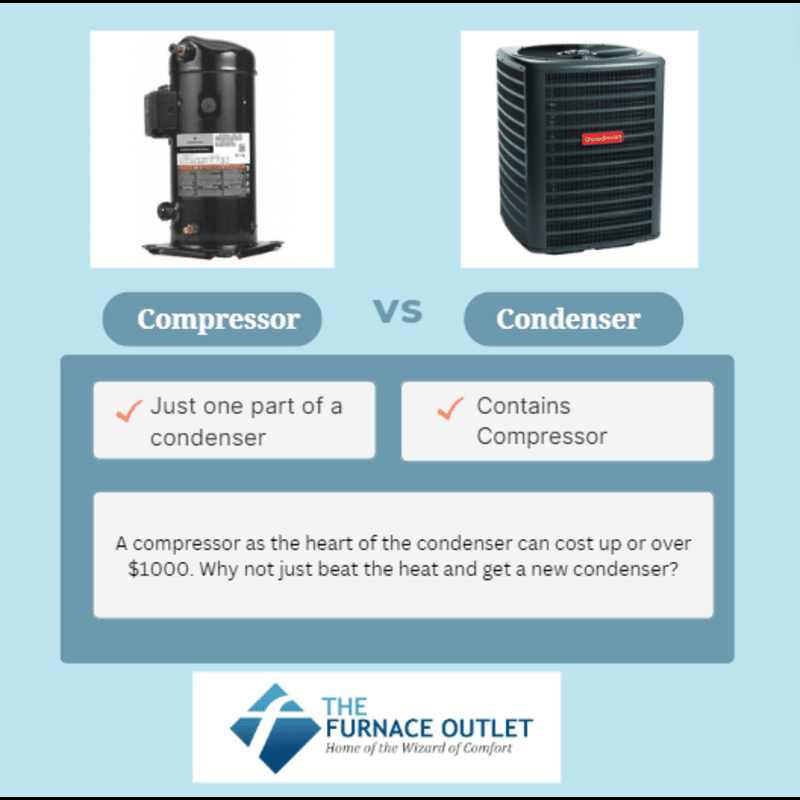When the sweltering heat of summer sets in, a well-functioning air conditioning system is more than a simple comfort—it's a necessity. For homeowners, understanding the key components of this climate control system, like compressors and condensers, can help in maintaining, diagnosing, and even troubleshooting potential problems before they lead to a breakdown.
The compressor and condenser are the unsung heroes within your air conditioning unit, playing pivotal roles in the cooling process. The compressor serves as the heart of the system, pumping refrigerant throughout, while the condenser acts as the hot side of the unit, dissipating heat removed from the indoors to the outside air. However, the entire outside component is known as an AC or heat pump unit or condenser although the condenser is a specific part within the unit.
The Compressor: The Heart of the Air Conditioner
Ever wonder why the compressor is often referred to as the 'heart' of the air conditioning system? Much like our own vital organ, the compressor is central to the system's circulation, ensuring the refrigerant flows and thus enabling the lifecycle of cooling to proceed.
Specifically, the compressor takes low-pressure gaseous refrigerant, compresses it into a high-pressure, high-temperature gas, and pushes it towards the condenser. This transition is essential for the refrigerant's journey and the air conditioning cycle's continuation.
The Condenser: Releasing the Heat
Picture the condenser as your AC's personal heat exchanger; it's where the high-temperature refrigerant released by the compressor turns into a liquid form after releasing its heat to the outside atmosphere. This process not only cools the refrigerant down but also sets it up for low-pressure conversion as it heads back to the indoor unit.
During this phase, the refrigerant sheds its heat to the surrounding air with the help of condenser coils and a fan. This transformation from a high-pressure gas to a high-pressure liquid is vital for the next step of chilling your indoor space.
Compressor and Condenser: Working Together
The compressor and condenser must work in unison for your home to enjoy the refreshing coolness. Together, they are integral to the refrigeration cycle. As the compressor pressurizes the refrigerant, the condenser cools it down, setting the stage for it to absorb indoor heat and then to release it outdoors.
A common misconception is that the air conditioning system generates cold air, but in truth, it's about heat exchange. Your compressor and condenser aren’t chilling the air but rather removing warmth from it and expelling it outside.
Types of Compressors Explained
Not all compressors are built alike; there are several types, such as reciprocating, scroll, and rotary compressors. Each has its unique advantages and is suited for specific applications. For example, scroll compressors are known for their durability and efficiency, often used in residential systems, while reciprocating compressors are typically found in smaller, portable units.
Reciprocating compressors use pistons and work similar to car engines, making them great for varied capacity needs. Rotary compressors, on the other hand, utilize a rotary-type motion, enabling quiet operation and making them ideal for businesses or areas where noise is a concern.
Maintaining Your AC's Compressor and Condenser
Keeping the compressor and condenser in top condition involves regular maintenance checks, including cleaning the coils, ensuring proper refrigerant levels, and checking for blockages or leaks. Preventive measures prolong the life of these components and maintain the efficiency of your system.
Signs that your AC unit may be failing include strange noises, a lack of cold air, or a system that constantly cycles on and off. These symptoms warrant a professional inspection to avoid further damage and costly repairs.
Repair Or Replace
The term "AC condenser" can refer to both a specific component within the outdoor unit of an air conditioning system and, colloquially, to the entire outdoor unit itself.
Specifically, the AC condenser is a vital part of the outdoor unit responsible for dissipating heat absorbed from inside the building to the outdoor environment. It contains coils through which refrigerant flows, and a fan blows outdoor air over these coils to facilitate the heat transfer process.
Colloquially, however, people often refer to the entire outdoor unit as the "AC condenser" or simply the "condenser." This unit typically includes not only the condenser coil but also other components such as the compressor, fan motor, and various electrical components.
So, while "AC condenser" can refer specifically to the coil component, it's also commonly used to describe the entire outdoor unit of an air conditioning system.
The compressor and condenser are central to a high-performing air conditioning unit, and understanding their functions can be vital for homeowners to prevent and address issues proactively. For those keen to dive deeper into maintaining your home system, The Furnace Outlet offers valuable content and products that could help keep your setup running optimally. Explore our range of HVAC selections to ensure your equipment stays in peak performance, sustaining freshness and comfort in your abode throughout the hottest days. If you’re looking for a unit to start you shopping experience on the Goodman 3 Ton 17.2 SEER Heat Pump is a great place to start.







